If there is one thing that modern customers crave for, it’s seamless 24×7 support experiences.
In fact, 74% of customers expect brands to have a self-service support portal.
But, providing them with online self-help options is one thing and delivering on your promise of a stellar self-service support experience is another.
One poor experience can dwindle their trust in your self-service platform, and by that extension in your brand.
The result? Your hard-earned customers vanish into thin air.
So, how do you improve your self-service portal and encourage your customers to use it for problem-solving? How do you deliver a ‘wow self-service support’ experience to keep your customers delighted?
This blog will reveal the secret sauce. But before that, let’s understand what exactly is self-service and the benefits it provides.
What Is Self-Service & What Are Its Benefits
Self-service is the practice of allowing customers to help themselves. Since modern customers prefer to be in the driver’s seat, i.e., fully in control of their decisions, the self-service approach works best for them.
With the increasing inclination of customers towards self-service, it’s about time brands started providing them with effective self-help options for problem-solving. One such option is the self-service knowledge base.
Most brands today provide customers with an online knowledge base, help center, FAQs, and more, with the objective of empowering customers to find help on their own.
This provides three significant benefits of self-service:
- If customers successfully find answers to their questions on your self-service platform, your support tickets start decreasing in number. This means agents don’t have to spend time answering common customer questions.
- It creates a positive perception of your brand. Since it takes customers less effort and even less time to get their issues addressed, they are always happy and satisfied with your brand and tend to stick longer with your brand.
- You are able to create an army of delighted customers and support agents. Your customers are happy that they don’t have to resort to emails and calls every time they have a question. On the other hand, agents get the time to focus on serious customer concerns.
Let’s now look at how you can promote the use of your self-service platform among customers.
8 Ways to Promote Your Self-Service Platform Among Customers
It’s common knowledge that customers prefer self-service platforms to solve basic issues regarding a company’s products or services.
But, most of the time, they still end up using the time-consuming emails and calls to seek support. There can be two reasons behind this:
- Lack of awareness about your self-service platform
- Ineffectiveness of your self-help portal in delivering accurate answers
Here are eight essential tips to enhance the performance of your self-service knowledge base. Once your self-service platform starts working well, more and more customers will become aware of its presence, and they will start using it actively.
1. Optimize Your Self-Help Portal for Search Engines
Is your self-help section hidden in some corner of your website?
There is a high chance customers won’t be able to find it. To avoid this, add it as a category on your website’s home page and ensure that customers don’t have to work hard to find it.
If you have a separate customer support portal, but it shows on the 3rd page of Google results, there is little to no chance of customers using it.
Optimizing it for search engines is the best solution here.
SEO optimization requires that you identify the trending keywords related to your knowledge base. Tools like Google Keyword Planner can help you here. Once you know the keywords customers are searching for, add them generously to your knowledge base in a way that makes sense.
Add meta description, meta tag, and meta title for every article and ensure that the content is of top-notch quality.
This will substantially increase the chances of your knowledge base showing in the first few Google search results. And when that happens, your customers will be able to find and use it instantly.
2. Provide the Information Your Customers Need
There is a difference between your self-help portal, having a lot of information, and having the right information.
Since customers will visit your self-help site only at times when they are confused or have unresolved issues, it’s essential to provide them accurate information. Fluffy content that doesn’t give any value to customers is a big NO.
Try to keep the content as simple and straightforward as you can. Talk to your sales and support staff to understand the bottlenecks customers face and ensure that your knowledge base addresses them.
For example, if you come to know that a few customers have been asking some questions repeatedly, such as :
- “How to install Live Chat on a website?”, or
- “How to monitor live chat operators’ performance?”
Make it a point to add these questions to your online help center. Provide customers the assistance they need right in your self-service portal and make problem-solving a breeze. This will help you promote your self-service platform among customers in the right way.
FREE. All Features. FOREVER!
Try our Forever FREE account with all premium features!
3. Focus on Its Design & Structure
It’s true that a book shouldn’t be judged by its cover. But you’d agree that having a nice cover and an overall decent design makes a book appealing for readers.
The importance of design and structure cannot be ignored. Content is the core of a self-help portal but how it’s displayed to customers is equally essential to keep them engaged.
Here are some hacks to have an attractive design and structure for your self-help portal:
- Add a table of contents with categories and subcategories or create a homepage where the main sections of the help center are displayed.
- Keep your paragraphs short and succinct. Long paragraphs are difficult to read and will make it hard for customers to grasp the information.
- Have short and active headings
- Use font styles that are easy to read. You can go for Calibri, Arial, or Times New Roman. Such fonts are easy on the eyes.
- Bold, italicize and underline content where you want to draw customers’ attention.
- Use soft shades, preferably blue, green, or yellow in your self-service platform. These indirectly help you calm down your frustrated customers.
- Don’t crowd your knowledge base with content. Have some breathing space so that customers don’t feel claustrophobic while traversing your knowledge base.
HighQ’s stunning customer support platform is a great example where you can find most of these elements.
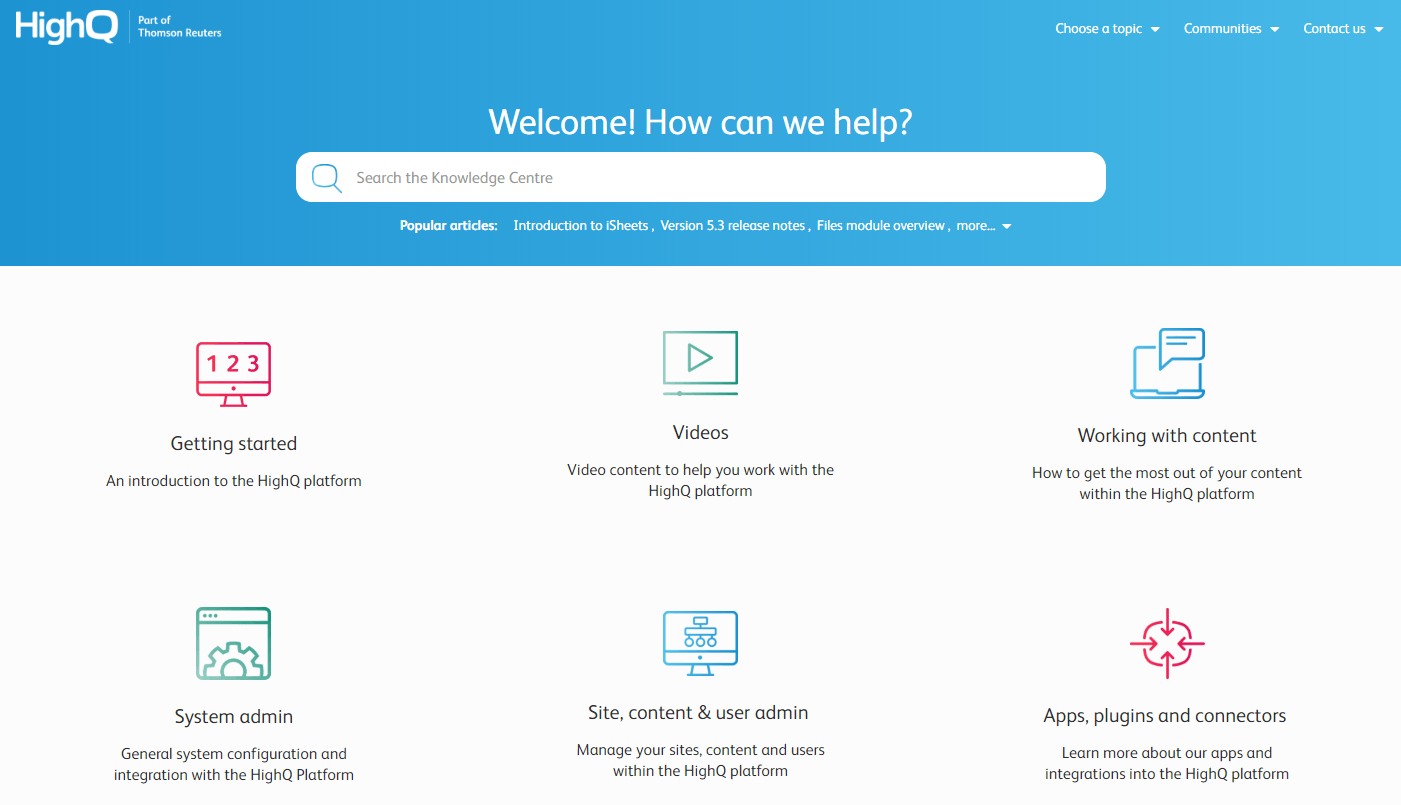
This is the homepage of HighQ’s customer support portal. It displays all the categories that the portal will be covering. Another thing to note here is branding. It’s consistent across all the pages.
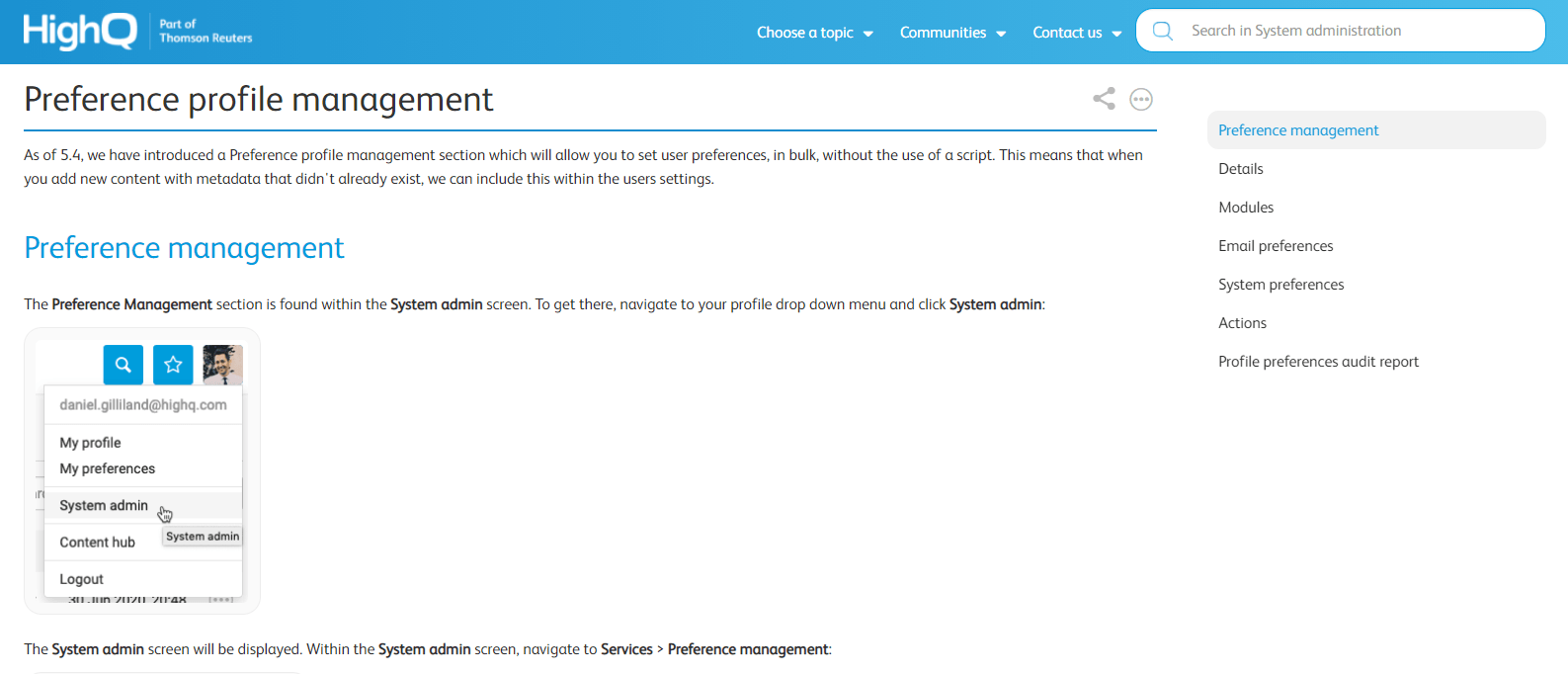
Here you can see short headings and to-the-point paragraphs with important words highlighted in bold. Besides, there is a lot of breathing space in its help section. You won’t be bombarded with information the moment you step in its help center.
4. Provide Agent Assistance on Your Self-Help Platform
Despite creating a stellar self-help portal, there might be instances where customers aren’t able to find answers to their questions. For such cases, it’s better to provide customers the option to chat with an agent right from within your self-help portal.
Agents will then handle the issues and most probably share the relevant article links with customers for quick problem-solving. If the information is not available in the portal, agents can provide the right solutions in the chat widget or create a ticket for the same.
Self-Service + Live Chat = A versatile customer support help center
This is a great way to ensure that customers get what they want and don’t walk away from your self-help portal disappointed.
Mimosa’s online help center serves as an excellent example. It provides customers the option to self-serve as well as chat with an agent.
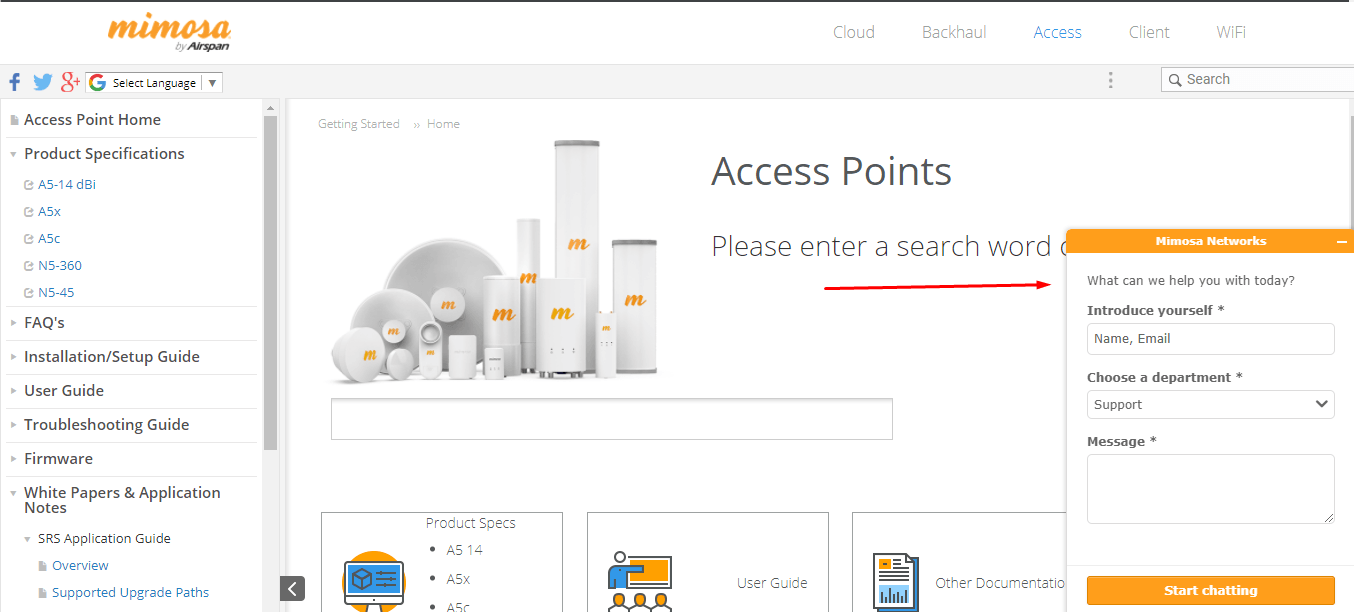
Image Source: Mimosa
5. Evaluate Self-Service Platform’s Effectiveness
You don’t want to provide stale, inaccurate, or irrelevant content to your customers, do you?
If you do that, you will drift customers away from your self-service portal. Therefore, it’s crucial to keep improving your self-help customer support center.
But, you cannot improve something that you don’t measure. That’s where self-service metrics come into play.
Tracking metrics such as customer requests raised via a self-service portal, Customer Satisfaction (CSAT) score of your self-help platform, bounce rate, and many more, can be of tremendous help in measuring the effectiveness of your self-service support center.
These metrics give you a sneak-peek into how adept your online knowledge base is in answering customer questions, engaging your customers, and keeping them delighted.
For instance, the bounce rate represents the number of people visiting your self-help center and leaving immediately without scrolling further. A higher bounce rate means reduced customer engagement and satisfaction, and a lower rate indicates good customer engagement.
Besides these metrics, you can even utilize insightful reports. If you use a good knowledge base tool, you will know what reports do. They give a transparent picture of:
- Articles rated poorly by customers
- List of keywords that failed to yield results
- Total number of searches
- New articles created and modified
- Broken links, and much more.
Leverage this goldmine of information to turn your self-service platform from average to awesome.
Read more: 6 Metrics to Measure & Improve Self-Service Effectiveness
6. Target Self-Service Platform Towards Customers Who Prefer to Self-Serve
Having a diverse customer base, you can’t expect all your customers to find your self-service platform attractive.
While millennials and GenZ will want a seamless self-service experience, GenX might prefer the conventional routes – emails and calls.
Therefore, it’s crucial to analyze your customer base and identify the customers who will prefer using your self-service platform. Assess your customer base on the basis of their age, location, channels they prefer for customer support, etc., and then create personas based on your analysis.
This will help you spot the personas who prefer your self-service platform more than other support options. Accordingly, promote your self-service platform to only those customers who actually want to use it.
For instance, If you ask a 65 years old customer to use your self-help portal to find information, chances are this action will backfire. He or she might find it clumsy to get help without external assistance, leading to frustration and disappointment.
On the contrary, a 30 years old customer who has no time to call or email for basic questions, will expect you to provide a self-help support system.
So, market your self-service platform to the right customers to ensure that it’s put to good use.
FREE. All Features. FOREVER!
Try our Forever FREE account with all premium features!
7. Make Your Self-Help Platform Easy to Understand
The chief purpose of your self-service platform is to make problem-solving a matter of minutes for your customers. Realizing this goal will be difficult if customers have to toil to understand the information provided.
If they can call your support staff and get an answer in 30 minutes, why will they read your self-help article to find the same information in 40 minutes?
Try to make the self-help platform as simple as you can. Use the language that customers can understand. There are times when you can’t help but use technical terms and concepts. The best way out here is to explain such terms right away.
Remove any language-related barriers that restrain customers from getting what they want in your self-service knowledge base. Tooltips, lightboxes, and popups offer a great solution to this problem. These three tools are your best bet to make information-gathering as easy as pie for your customers.
Tooltips are excellent for explaining product features, providing pricing disclaimers, explaining policies, and much more. It looks something like this –
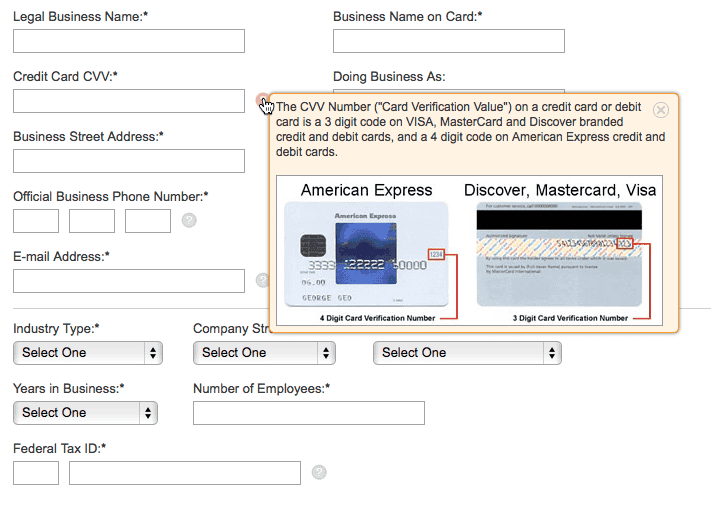
Lightboxes work perfectly for providing product tours to new customers and delivering procedural help content. These are interactive and come with a scroll bar effect.
Popups are great for displaying interactive content such as images and icons. It’s great for providing additional information to readers.
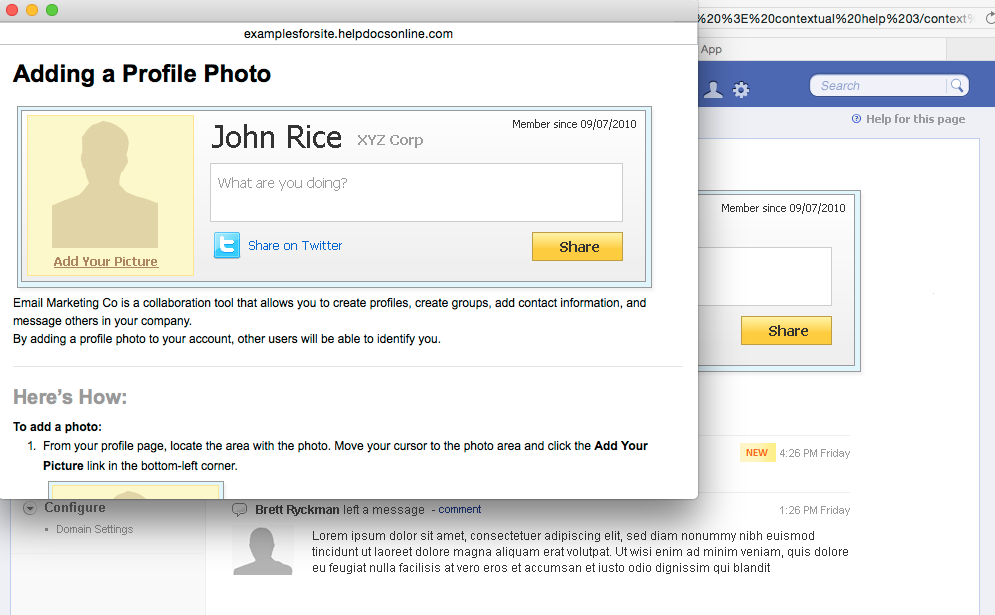
Embed tooltips, lightboxes, and popups at places where you feel customers will need clarification or additional help. This will clear all the bumps customers face while searching for information.
8. Provide Friction-Free Experiences
To increase self-service platform adoption, it should provide them with smooth, enriching experiences.
That being said, your online knowledge base should have a robust search system that gives content suggestions at lightning-fast speed, similar to how Google works.
For that to happen, ensure that you have added the relevant keywords across all articles, and your content is of superlative quality.
Mimosa has done a great job of creating a Google-like search system. Have a look.
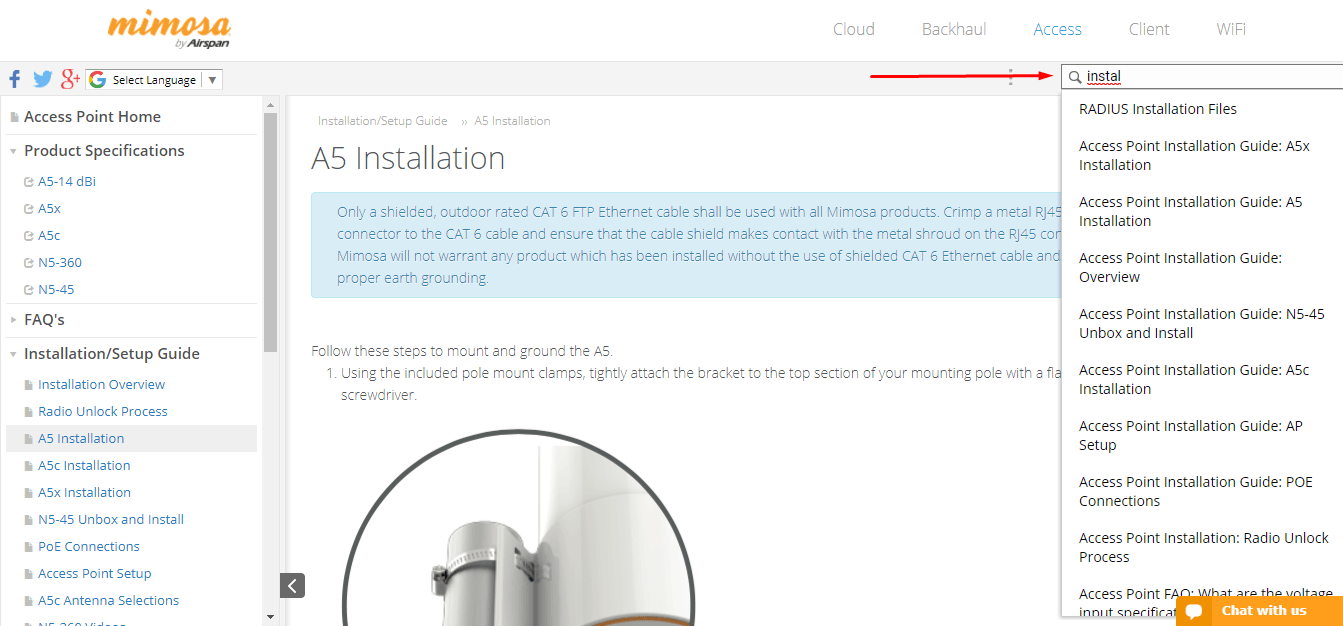
Image Source: Mimosa
Besides, you can even use internal linking to make navigation easy for customers and direct them to the right article quickly.
For instance, in a paragraph on ‘How to install the software’, there is a mention of one of the software’s features. If you have a separate article on that feature, you can link it to this term. A customer looking for information specific to this feature will be able to find it quickly, even if he or she is on the wrong page.
Make your search seamless and navigation friction-less to deliver exceptional self-help experiences to your customers.
It’s Time To Sweep Customers off Their Feet
The adage ‘Self-help is the best help’ stands true in today’s digital-dominated world.
A self-service platform provides a wonderful way to serve speed and convenience to your customers. But, when that doesn’t happen, customers start losing trust in the entire self-service system, and they eventually turn to tried and tested calls and emails.
Prevent that from happening by working proactively towards improving your self-service platform. Popularize your self-help platform, focus on its design and structure, add live chat to your self-service portal, and keep measuring and improving its performance.
Embrace a robust knowledge base tool to make your customers fall in love with your self-service platform and with your brand.
Frequently Asked Questions
What are the self-service options?
Self-service options are the ones that empower customers to solve any issues they have on their own. Brands usually create a self-help center to enable customers to find answers to their questions in minutes.
What is a self-service model?
Self-service models are preferred by businesses to allow customers to carry out purchases and address any issues during and after the purchase process on their own.
Do customers prefer self-service?
Yes, customers prefer self-service more than anything else. Modern customers crave instant and seamless self-service experiences that help them address their concerns in a hassle-free way.
 Tips
Tips
We’d love to hear your tips & suggestions on this article!
FREE. All Features. FOREVER!
Try our Forever FREE account with all premium features!

 We'd love your feedback!
We'd love your feedback! Thanks for your feedback!
Thanks for your feedback!







